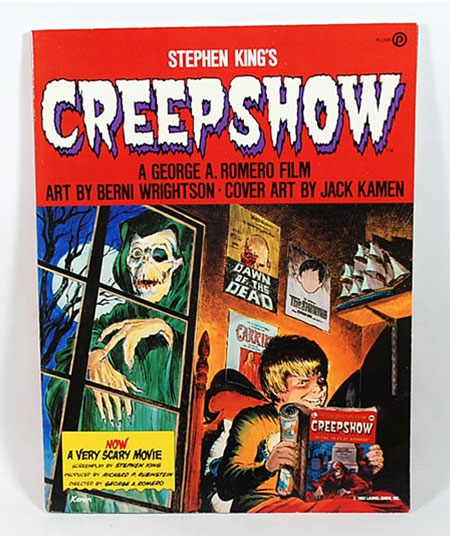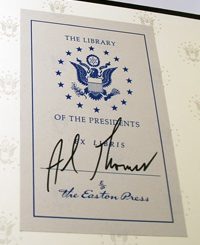 If you are considering a book to add to your library, one of the most important factors will be the condition of that book. While valuation is somewhat subjective, as different sellers will have different ideas as to what constitutes a book’s condition, there are, generally speaking, some overall standards you can expect from experienced booksellers. And the standards at the top of the grading scale are (or should be) universal and non-negotiable.
If you are considering a book to add to your library, one of the most important factors will be the condition of that book. While valuation is somewhat subjective, as different sellers will have different ideas as to what constitutes a book’s condition, there are, generally speaking, some overall standards you can expect from experienced booksellers. And the standards at the top of the grading scale are (or should be) universal and non-negotiable.
Customarily, a book’s assessed condition will be relative to its age. In other words, the reasonable expectations of a book that is one hundred fifty years old and considered to be in “fine condition,” will be somewhat different than a book that is only fifty years old and considered to be in “fine condition.” In the case of the latter, perfection should be expected; while in the case of the former, one should expect something closer to near perfection.
This also brings the notion of scarcity into the mix when considering condition. Is the book in question extremely rare and it is unlikely you will run across another copy in the near or distant future? This factor should be taken into consideration when contemplating a book’s condition, against the asking price, combined with the probability of ever coming across a better copy. When it comes to books that are not extremely rare, collectors have variant thoughts on whether or not to purchase a book that is in less than “fine” condition: some preferring to have the book, regardless, as part of their collection, with the plan that should the opportunity arise to replace the book with an upgrade, they will do so; while others prefer to wait until they have the opportunity to purchase a “fine” copy from the get-go. Neither approach is right or wrong, as collecting is a personal thing.
Let’s take a look at the standard terminology, which you can consider to be a sort of grade-point scale—in some cases as mentioned, as with antiquity, on a curve.
Very Fine / Mint / As New / Like New: These seem like four different grade-points, don’t they? And for some sellers, they may offer a distinction between them; though more commonly you’ll see these terms used interchangeably. Any of these terms should indicate a book with no defects or flaws to note. This should indicate a bright, clean copy, with all pages and the spine fully in tact; no creases, bumps, attached bookplates or clipped dust jacket. This will be the highest grade given to any copy—indicating books that have never been read, or at least appear to have never been read. “As New” and “Mint” will often still be encased in the publisher’s original shrink-wrap…unless it’s a book that predates such packaging. Note: A book can have its original shrink-wrap removed and still be in “very fine” condition.
Fine: This would be a book that is almost “Like new.” It will have no overt flaws, and possibly only very minimal signs of use. This means no missing leaves, an unclipped dust jacket (if the book was issued with one), no damage to the spine, no stains or fading. Any minor blemish in the book or dust jacket must be noted in description. As previously alluded to however, if the book predates the 19th Century, a different standard should be applied. With books of antiquity, more signs of use will be acceptable, though again, no overt defects.
Near Fine: This book will be close to “Fine” and may present a minor flaw or flaws which will be detailed by the seller. A book listed as “Near Fine” might show some very slight flaws such as slight creasing, but no overt defects such as markings, writings, stamps, attached bookplates, ripped or missing leaves, and so forth.
Very Good: You may on occasion find this term used interchangeably with “Near Fine.” On occasion. Remember, these terms are to some extent subjective. Yet there are definite differences between the two. Note that from this point on down the grade-point scale you may encounter a plus or minus, to give the potential buyer a quick indication of how close the book’s condition may be to a step above (Near Fine) or the next step down (Good). So you may, for example see VG+ or VG++. A book listed as “Very Good” will definitely show some signs of wear along with defects that are still considered “minor.” These might include minor rubbing, minor soil, a possible bump to a corner, but still nothing major such as tears, cracked spines, or missing leaves.
Good: Here is the middle of the road. “Good” will be most often used to describe the average used book and is the lowest grade given to a collectible copy. A book in this condition may present some minor age-related spots or browning (what’s known as “foxing”). The spine may present wear but should still be in tact, and bumped corners are considered acceptable at this grade. If the book is extremely old, it may present a loose or even missing endpaper, and more browning might be expected.
Non-collectible ratings…..
Fair: This book will be noticeably worn and will exhibit multiple defects. These may include scuffs and scrapes, substantial foxing or dampstains (water damage), missing endpapers, excessive creasing or dog-earing of leaves. A book in this condition would not be a good investment to your collection, except, again, in rare instances where the book is so rare that the probability of ever finding a better copy is highly unlikely.
Binding Copy: This is a book in which the text block including illustration pages are complete and the book (pages and covers) is in otherwise very good condition, but the book spine, backstrip or casing will need replacing. In some cases, however, restoration of the binding may prove difficult or impossible, depending on the extent of the damage.
Reading / Poor: A book given the designation of “Reading Copy” or “Poor” is basically a book that is still readable, but otherwise in poor condition. While some consider this designation interchangeable with “Binding,” a Reading/Poor copy will present serious defects beyond the condition of the binding. Signs of excessive wear, stains, loose leaves, scuffs, dents, heavy soiling, missing illustrations, cracked hinges, front boards detached, and so forth. This is a book that will not merit restoration attempts.
Uncollected Conditions: This designation is given to a book that is not whole, either in text block or binding. This would include copies such as ex-library books, with lending library book plates, glued on lending sheets with abundant rubber stamping, pockets adhered to the endpapers, often in poor condition. While the book may still be readable, a book in this condition is not collectible.
In summary, when you are seriously considering a purchase for your collection, it is important to remember that the further down the grade-point scale, the more increasing is the importance of paying close attention to the details. The terms “Very Good,” “Good” and so forth should be treated as a summary in one word of the seller’s assessment of the book. Always read the details because in doing so, you may discover the book is in better or worse condition than you may have thought. And be wary of condition descriptions that are lacking. Aside from books that are “Mint,” “As New,” “Sealed” and in most cases (when dealing with reputable sellers) “Very Fine,” any other designation should be followed by specifics. Finally, reputable booksellers will offer a money-back policy because they want you to be happy with your purchase.
Happy book hunting!



Leave a Reply